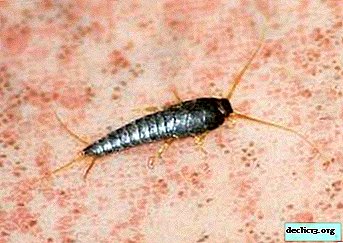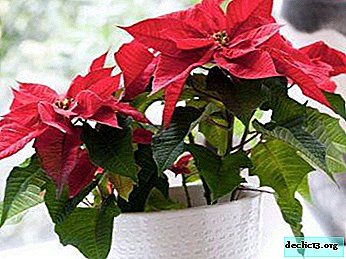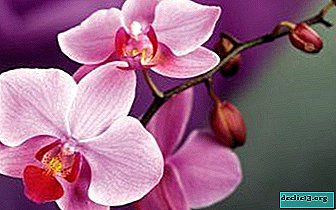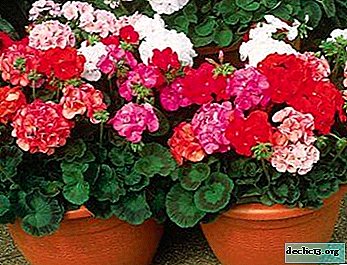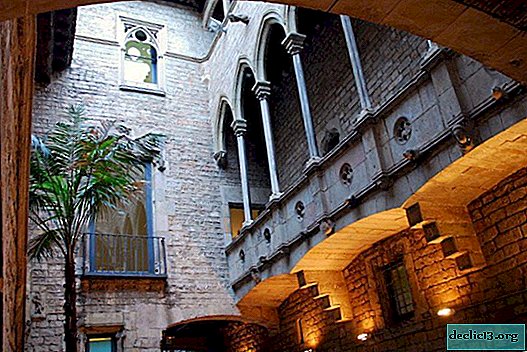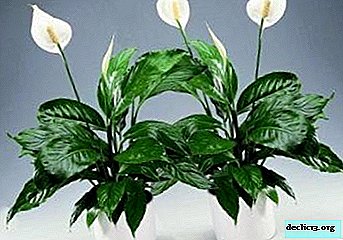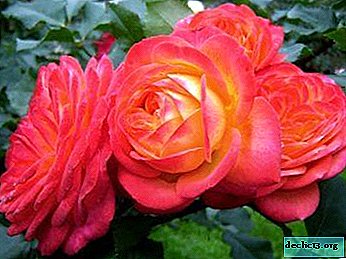Unpretentious Syrian hibiscus chiffon. Description Magenta, White and other subspecies, the rules of cultivation and care
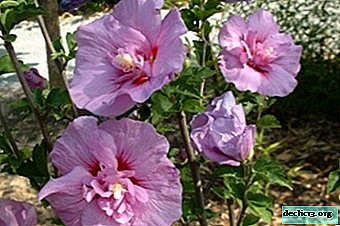
Tropical plants cultivated for our climate have a very unusual and beautiful look.
One of these plants is the Syrian hibiscus Chiffon. It is often used as plants for landscaping cities.
A fairly unpretentious culture with history can please every gardener and just an amateur.
Today we will talk about how to care for a plant and plant seeds and cuttings.
General description
Syrian hibiscus (lat. Hibiscus syriacus Chiffon) - a representative of the family Malvaceae, there are about 300 species. Hibiscus is a deciduous shrub growing up to 5-6 m. It has a tree-like, cone-shaped stem of gray color with leaves. Medium-sized leaves (10 cm.). Large flowers - diameter 20 cm. Coloring of flowers from white to purple. Hibiscus blooms from July to October. Many kidneys are formed. Frost-resistant look.
The hibiscus is called the “flower of beautiful women”, as in the Hawaiian Islands, girls braid it in their hair. And in India, the local plant is inserted into wedding wreaths. Also, hibiscus is called a Syrian rose or ketmy.In Europe, the plant appeared around the XVIII century, and planted it in greenhouses and botanical gardens. And at the end of the 20th century, Professor R. Woods bred varieties of Syrian hibiscus Chiffon. Homeland of hibiscus tropics and subtropics. It grows in China, Korea and West Asia. Gained popularity in the south of Russia, Ukraine, in Central Asia for cultivation in the open ground.
Subspecies
Pink

Cultivated hibiscus. Vivid features: compact crown shape, large double flowers of a pink hue. It grows up to 2 m in height and in diameter. It blooms all summer. He needs warmth, light and non-acidic earth.
Video with the description of hibiscus Pink:
Magenta (Magenta)

The bush grows to 3 m. A diameter of approximately 2 m. In diameter. The flowers themselves are 10-12 cm. Red with purple, terry. Frost-resistant, therefore suitable for mid-latitudes. It blooms from August to October.
China (China)

Deciduous shrub up to 2.5 m tall. In diameter 1.5 m. The leaves are oval in shape, bright green, 10 cm. Flowers are also approximately 10 cm. White in color with red and raspberry stripes in the middle. It blooms from summer to frost. The plant needs moderate watering.
White

Tall bush up to 3 meters. Diameter 60 cm. Dark toothed leaves. The bush is covered with large (10 cm.) Double white flowers. There are a lot of yellow leaves in the middle.
Video about the hibiscus white variety:
Lavender

In height - 4 m. Oval leaves, bright green (10 cm.). The buds are soft lavender (the name went from color). Terry mid. It blooms all summer, but requires a lot of light.
Outdoor Care
Temperature
Hibiscus likes heat (20-25 ° C). If it is well watered, it will tolerate the heat. And in winter it lives even at -25 ° C.
Watering
It is carried out every other day (in summer) with warm and clean water. And only when the soil near the bush is dry.
Shine
It should be diffused, but bright, as direct lighting can damage the leaves. Flowers do not develop well in the shade.
Priming
Loose, light, fertile and permeable:
- sheet land - 3 parts;
- turf land - 4 parts;
- sand - 1 part;
- humus - 1 part;
- drainage (crushed stone, expanded clay, ceramic fragments).
Pruning
It is carried out in the spring (one third) and in the fall (old stems are removed). The plant needs sanitary pruning. Formative is sometimes required.
- Only a bush planted shortens the branches to 2 or 3 buds.
- The next pruning is lateral shoots up to 1-2 buds, trunk up to 5-6 buds in the last weeks of winter.
Top dressing

- In early April, fertilizer for better growth.
- From June to September, phosphorus and nitrogen fertilizers.
- Before winter - potash.
- The plant is also fertilized every 2 weeks by top dressing with iron and magnesium.
- Liquid fertilizer through watering. And granules and powder are introduced into the soil after watering.
- Humus, compost, peat alternate with mineral top dressing.
If the bush provides good care, it will bloom very magnificent, and immediately after the withering of one flower, another will blossom.
Transfer
Held in early spring. Process:
- pit preparation;
- pulling a plant out of a container with earth and roots;
- pruning of dry root processes;
- installation of a bush in a hole, backfilling with soil;
- plentiful watering;
- mulching the top layer.
Wintering
- For warm climate sheltering plants is not necessary. Just prune the bushes, mulch the soil with leaves, peat or cover with coniferous spruce branches.
- In temperate climates Stronger protection is required - to cover the bushes with conifer, straw, agrofibre.
- If it’s very cold in winter - Dig out hibiscus and transplant it into a well-lit place in the house. After winter, adaptation is needed. Therefore, shelter is not removed immediately.
Planting and growing from seeds
 The procedure is as follows:
The procedure is as follows:
- Stratification.
- The distribution of seeds in containers 5-7 cm apart.
- Powder sand and peat.
- Moisturizing.
- Covering with a film.
- Ventilating seedlings (daily).
- Further, when several leaves appear, pick.
- Landing in the open ground (mid-May).
Cuttings
It is recommended to cut it after spring pruning. Need to:
- Choose healthy adult shoot tips.
- Tear off the bottom leaves at the base.
- To dry.
- To process with fertilizer.
- Put the cuttings in water.
- After 3-4 weeks, drop it into separate containers filled with a mixture of peat, sand and earth.
- After the appearance of the first shoots, you need to pinch them.
The rooting temperature is 18-22 ° C. Regular watering is required.
Possible problems
Pests
Hibiscus is resistant to pests and diseases. However, it can be settled:
- aphid;
- spider mite;
- greenhouse whitefly;
- worms;
- scale insects;
- gall midge.
In order to get rid of them, you need to spray the bushes with an insecticidal solution 2 times with a break of 7-10 days. Pests settle on hibiscus after contact with diseased flowers, with poor watering, or when transplanted into infected soil.
Diseases
Most often, hibiscus is ill with chlorosis. The lower leaf plates fly around him, and young leaves grow a pale yellow hue. This is due to a lack of iron and nitrogen in the soil. Therefore, you need to fertilize the earth. If you do not follow the rules for the care of hibiscus, the plant will begin to hurt.
Similar flowers

- Terry Calistegia (Siberian rose). The buds of pale pink color last until the end of autumn.
- Mallow is pink. High bush (2 m.). Large flowers of different shades.
- Mallow forest "Moravia". 1.5 m high. Bright pink with red stripes on the petals.
- Mallow forest "Primley Blue." The flowers are purple, but light, large.
- Hollyhock "Chater's Double Icicle". White flowers with terry fringing.
Hibiscus Syrian Chiffon is a very beautiful and showy plant, delighting its owner with lush flowering. He is quite unpretentious in handling. Therefore, subject to a small number of rules, expect a corner of beauty in your garden. The Syrian hibiscus that came from distant lands took root, and then hybrid varieties, including Chiffon, were bred. And now every lover can grow it.



